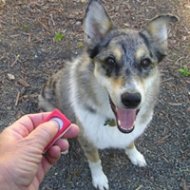different dog training methods
 While many dog training methods exist, they all center around a few basic concepts. You can use positive reinforcement, negative reinforcement, or a combination of the two. But which training method is best? Nearly all trainers will use some sort of combination of the two. The difference between various dog trainers is how much of each method they use and to what degree. Here’s a rundown on how positive reinforcement, negative reinforcement, and some of the more popular training methods work.
While many dog training methods exist, they all center around a few basic concepts. You can use positive reinforcement, negative reinforcement, or a combination of the two. But which training method is best? Nearly all trainers will use some sort of combination of the two. The difference between various dog trainers is how much of each method they use and to what degree. Here’s a rundown on how positive reinforcement, negative reinforcement, and some of the more popular training methods work.
When using positive reinforcement training methods, the trainer (that’s you!) will reward a dog for performing desired behaviors. While it has always been used in some respect, only recently has it become such a large factor for so many trainers. Many of them make it the focal point of their entire obedience training class. I find that using one method or another exclusively doesn’t usually yield very good results. Every dog needs a balance between the two. That balance will depend on each individual dog and each individual trainer. It’s important that your dog sees training as a fun and positive experience, though. This guide will help show you how positive reinforcement training should be used.
 This clicker training guide will explain how clicker training works and how to get started. Clicker training uses a device which creates a sound (a click, as you might imagine) to communicate to your dog that he or she performed a desired behavior. The dog will begin to associate the sound of the click with a treat or reward. Once the dog learns which behavior creates the click, they want to do it over and over again! For example, when teaching your dog to “sit” you would click as soon as your dogs butt touches the floor, followed by a treat. When the dog hears the click, the dog begins to associate “sit” with a “click” which equals treat! While clicker training is nothing new, it has absolutely sky rocketed in popularity over the past several years and with good reason. Clicker training is humane, fun, and very highly effective. If you aren’t already familiar with clicker training, you’re missing out on a wonderful training technique.
This clicker training guide will explain how clicker training works and how to get started. Clicker training uses a device which creates a sound (a click, as you might imagine) to communicate to your dog that he or she performed a desired behavior. The dog will begin to associate the sound of the click with a treat or reward. Once the dog learns which behavior creates the click, they want to do it over and over again! For example, when teaching your dog to “sit” you would click as soon as your dogs butt touches the floor, followed by a treat. When the dog hears the click, the dog begins to associate “sit” with a “click” which equals treat! While clicker training is nothing new, it has absolutely sky rocketed in popularity over the past several years and with good reason. Clicker training is humane, fun, and very highly effective. If you aren’t already familiar with clicker training, you’re missing out on a wonderful training technique.
 Negative reinforcement dog training has been given a bad name over the years, but in reality, nearly all trainers use negative reinforcement to some degree. It’s an important and necessary part of successfully training your dog. Negative reinforcement doesn’t have to be (and shouldn’t be) abusive or cause harm to your dog. This may seem obvious, but many people use negative reinforcement in a very inhumane way and others are under the impression that negative reinforcement needs to be painful. Negative reinforcement could be as simple as turning your back and ignoring your dog during unwanted behaviors. While physical corrections can also be used, there are ways to use them without inflicting fear and pain. Unfortunately, there are still quite a few dog trainers that use “old school” punishment methods and include painful physical corrections as a part of their training classes. Using choke chains, prong collars, shock collars, or pinch collars can be used in a safe, humane, and non-painful way. These devices are only abusive if you make them that way. When used correctly, they can be a very effective communication tool to use with your dog. When you’re able to properly communicate with your dog, your dog can better understand what is expected of him or her. When your dog has a clear understanding of what’s expected, everyone wins (especially your dog).
Negative reinforcement dog training has been given a bad name over the years, but in reality, nearly all trainers use negative reinforcement to some degree. It’s an important and necessary part of successfully training your dog. Negative reinforcement doesn’t have to be (and shouldn’t be) abusive or cause harm to your dog. This may seem obvious, but many people use negative reinforcement in a very inhumane way and others are under the impression that negative reinforcement needs to be painful. Negative reinforcement could be as simple as turning your back and ignoring your dog during unwanted behaviors. While physical corrections can also be used, there are ways to use them without inflicting fear and pain. Unfortunately, there are still quite a few dog trainers that use “old school” punishment methods and include painful physical corrections as a part of their training classes. Using choke chains, prong collars, shock collars, or pinch collars can be used in a safe, humane, and non-painful way. These devices are only abusive if you make them that way. When used correctly, they can be a very effective communication tool to use with your dog. When you’re able to properly communicate with your dog, your dog can better understand what is expected of him or her. When your dog has a clear understanding of what’s expected, everyone wins (especially your dog).


Related posts:

 MARY ISENHOUR-LONG Owner - Trainer Photo by Stewart Event Images About The Trainer The phrase, “gone to the dogs”, is certainly an appropriate one to describe my…
MARY ISENHOUR-LONG Owner - Trainer Photo by Stewart Event Images About The Trainer The phrase, “gone to the dogs”, is certainly an appropriate one to describe my… 6 Principles of Successful Training 1. Be Consistent: Apply the same rules and the same words all the time. 2. Be Concise: Give your command just once. Repetition…
6 Principles of Successful Training 1. Be Consistent: Apply the same rules and the same words all the time. 2. Be Concise: Give your command just once. Repetition… Cesar Millan Cesar is a best-selling author, public speaker, and internationally acclaimed star of the TV shows “Dog Whisperer with Cesar Millan, ” “Leader of the…
Cesar Millan Cesar is a best-selling author, public speaker, and internationally acclaimed star of the TV shows “Dog Whisperer with Cesar Millan, ” “Leader of the… At Monument Dog Training, we believe that change is always possible . We regularly resolve aggressive behavioral issues, even with dogs who have been written off…
At Monument Dog Training, we believe that change is always possible . We regularly resolve aggressive behavioral issues, even with dogs who have been written off… After years of working with thousands of dogs and their owners, I have seen that the key ingredient people are actually looking for is how to be the Pack Leader…
After years of working with thousands of dogs and their owners, I have seen that the key ingredient people are actually looking for is how to be the Pack Leader…